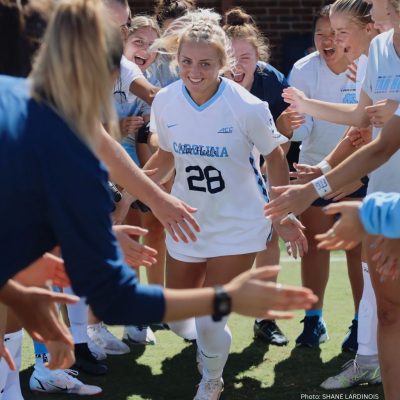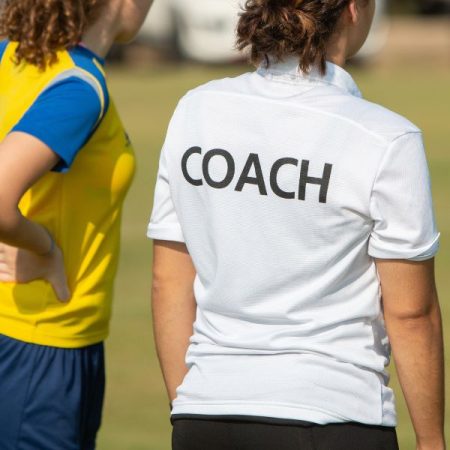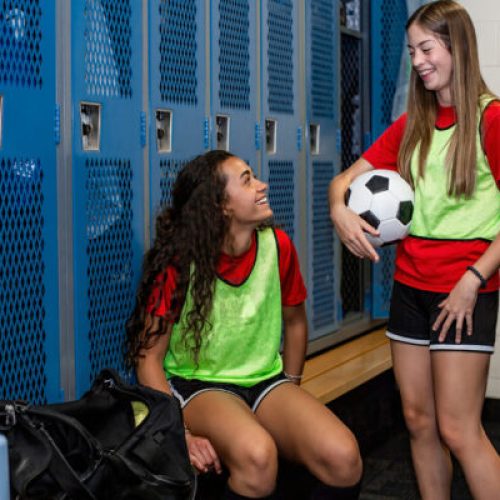College Soccer Recruiting Guide for High School Girls for the 2023 Season
Kickoff
The world of women’s college soccer recruiting can be competitive and overwhelming. Still, you can navigate the process successfully with the proper knowledge and preparation.
This comprehensive guide will walk you through every step of the journey, from understanding the recruitment timeline to creating an impressive recruiting video.
Whether you’re just starting to explore your options or are actively pursuing a college soccer scholarship, this guide is here to help you make informed decisions and maximize your chances of getting recruited.

Table of Contents
Understanding the Women's Soccer Recruiting Landscape
Before diving into the specifics of the recruiting process, it’s crucial to have a solid understanding of the women’s soccer recruiting landscape.
Over 1,500 colleges in the United States have women’s soccer teams, offering many opportunities for student-athletes. These colleges are in different divisions, including NCAA Division 1, Division 2, and Division 3, as well as NAIA and junior colleges. Each division has its own set of rules and regulations regarding recruiting and scholarships.
It’s important to note that women’s soccer is a highly competitive sport, and only a small percentage of high school players go on to play at the college level. According to statistics, about 9.7% of high school women’s soccer players compete in college, and only 2.3% play at the NCAA Division 1 level.
However, with the right approach and dedication, you can increase your chances of standing out to college coaches and securing a roster spot.
The College Recruiting Mistakes to Avoid - Video with Libby Moore, UNC Alum
Researching and Identifying Target Schools
The first step in the women’s college soccer recruiting process is to research and identify target schools. Start by considering your academic and athletic goals, as well as your personal preferences for location, school size, and other factors that are important to you. Make a list of 20 to 30 schools that align with your criteria, including a mix of safety schools, target schools, and reach schools.
Next, gather information about each school’s soccer program, including their performance in recent seasons, coaching staff, playing style, and roster composition. Visit the school’s official website, read news articles and press releases, and follow their social media accounts to understand the program’s values and culture. Pay attention to any specific requirements or preferences the coaches may have for recruits, such as preferred positions or playing style.
Evaluating Your Athletic Talent and Potential
As a prospective college soccer player, it’s essential to have a realistic evaluation of your athletic talent and potential. This self-assessment will help you determine the division level that is the best fit for your skills and abilities. Consult with your current coach or seek the guidance of a third-party evaluator, such as NCSA, to objectively assess your strengths and areas for improvement.
Consider your technical skills, physical attributes, tactical understanding, and mental toughness. Reflect on your performance in competitive matches and evaluate how you stack up against players at the college level. Be honest with yourself about your potential for growth and development over the next few years.
Understanding the Women's Soccer Recruiting Landscape
The women’s soccer recruiting timeline can vary depending on the division level and the specific college program. However, there are general guidelines that can help you navigate the process efficiently. It’s important to note that recruiting in women’s soccer often starts early, with coaches evaluating talent as early as 8th grade. Here’s a breakdown of the typical timeline:
- Freshman and Sophomore Years: Use these years to focus on skill development, academic achievement, and building a solid foundation for your recruiting journey. Attend camps, showcases, and tournaments to gain exposure and showcase your abilities to college coaches. Start researching and reaching out to colleges to express your interest.
- Junior Year: This is a crucial year for recruiting. College coaches can start contacting you directly on or after June 15th, after your sophomore year. Be proactive in contacting coaches, attending camps and tournaments, and updating your recruiting profile. Take unofficial visits to colleges to get a feel for the campus and the soccer program.
- Senior Year: By senior year, you should have narrowed down your list of target schools and be actively communicating with coaches. Official visits can start on August 1st, before your senior year. Make your final decision and sign the National Letter of Intent (NLI) to secure your roster spot.
Tips to Achieve Your College Soccer Dreams - Video with Maggie Pierce (UNC Alum)
Showcasing Your Skills: Creating an Impressive Recruiting Video
A well-crafted recruiting video is one of the most essential tools in your college soccer recruiting arsenal. While coaches prefer to see players compete in person, a highlight video allows them to evaluate your skills and abilities even if they can’t attend your matches. Here are some tips for creating an impressive recruiting video:
- Keep it concise: Aim for 3 to 6 minutes of video. Coaches are busy and have limited time, so grab their attention quickly.
- Highlight your best plays: Start the video with your most impressive plays to make a solid first impression. Include a mix of offensive and defensive highlights to showcase your versatility.
- Showcase your technical skills: Include clips demonstrating your technical abilities, such as dribbling, passing, shooting, and defending. Show your range of skills and highlight your strengths.
- Provide context: Add text or voiceover to provide context for each clip. Mention essential details such as the opponent, the score, and any notable achievements during the play.
- Use multiple camera angles: Include footage from different angles to give coaches a comprehensive view of your performance. You can include close-ups, wide-angle shots, and aerial views.
Remember to make your video easily accessible by uploading it to a platform like YouTube or Vimeo. Include the video link in your emails to coaches and on your online recruiting profile.
Reaching Out to College Coaches
Once you have identified your target schools and created an impressive recruiting video, it’s time to contact college coaches. Personalized and thoughtful communication is vital to grabbing their attention and showing your genuine interest in their program. Here are some tips for effectively contacting college coaches:
- Write a compelling introductory email: Craft a well-written email introducing yourself to the coach. Include relevant information such as your name, graduation year, position, club or high school team, academic achievements, and a link to your recruiting video. Express your interest in the program and ask for an opportunity to discuss your potential as a player.
- Follow up with a phone call: After sending the introductory email, follow up with a phone call to the coach. Introduce yourself again and reference the email you sent. Express your enthusiasm for the program and ask if they have any questions or need further information. Be prepared to have a brief conversation about your soccer background and goals.
- Attend camps and showcases: Participate in camps and showcases where college coaches will be in attendance. This allows coaches to see you play in person and interact with you directly. Research the events beforehand and come prepared to perform at your best.
- Build relationships: As you continue communicating with coaches, build genuine relationships. Respond promptly to their emails or calls, ask thoughtful questions, and express gratitude for their time and consideration. Coaches are not only evaluating your skills but also assessing your character and coachability.

Navigating the Women's Soccer Scholarship Process
Securing a soccer scholarship can significantly alleviate the financial burden of a college education. However, it’s essential to understand that scholarships in women’s college soccer recruiting are not guaranteed and are awarded at the discretion of the college coaches. Here’s what you need to know about the women’s soccer scholarship process:
- Scholarship availability: Scholarships are available at the NCAA Division 1 and Division 2 levels, NAIA schools, and junior colleges. Division 3 schools do not offer athletic scholarships but may provide other financial aid.
- Scholarship distribution: Women’s soccer scholarships can often be allocated among multiple players, with coaches having the flexibility to allocate scholarship funds as they see fit. Full-ride scholarships are less common, and most athletes receive partial scholarships that cover a portion of their tuition and other expenses.
- Scholarship negotiation: If you receive multiple scholarship offers, you can negotiate with coaches to increase the scholarship amount. Be prepared to demonstrate your value to the program and highlight any unique skills or achievements that set you apart.
- National Letter of Intent (NLI): Once you have decided which college to attend, sign the NLI to commit to the program officially. The NLI is a binding agreement between you and the college, ensuring your spot on the team and securing your scholarship. Click to Learn More about NCAA’s Rules for NIL
Maximizing Exposure: Tournaments, Camps, and ID Clinics
Participating in tournaments, camps, and ID clinics is a crucial aspect of the women’s soccer recruiting process. These events provide valuable opportunities to showcase your skills, compete against top-level players, and catch the attention of college coaches. Here are some types of events to consider:
- Club tournaments: Club tournaments attract college coaches actively scouting for recruits. Research tournaments in your area or national level that are known for attracting college coaches. Check the list of attending coaches and reach out to them beforehand to express your interest.
- College ID camps: College ID camps can provide exposure to college coaches while receiving coaching and feedback from them. These camps often include training sessions, scrimmages, and informational sessions about the college soccer program. Research colleges that offer ID camps and register for those that align with your target schools.
- Showcases: Showcases bring together top-level players from different regions and provide an opportunity to compete against intense competition. These events attract college coaches from various programs, allowing you to make a lasting impression. Research showcases a strong reputation and considers participating in them.
Attending these events requires careful planning and preparation. Please communicate with your club or high school coach to ensure that you have their support and guidance throughout the college soccer recruiting process.
Utilizing Women's Soccer Recruiting Services and Resources
Navigating the women’s soccer recruiting process can be overwhelming, and that’s where recruiting services and resources can be valuable. These services provide guidance, support, and access to a network of college coaches. Here are some ways you can utilize women’s soccer recruiting services:
- Online recruiting platforms: Online recruiting platforms, such as NCSA, provide a centralized hub for athletes, coaches, and families. These platforms allow you to create and update your recruiting profile, showcase your skills and achievements, and connect with college coaches.
- Recruiting consultants: Recruiting consultants offer personalized guidance and support throughout the recruiting process. They can help you develop a recruiting strategy, identify target schools, and provide feedback on your materials. Research reputable recruiting consultants and consider their services if you need additional assistance.
- College soccer websites and forums: Numerous websites and platforms are dedicated to recruiting college soccer, providing valuable information and insights. These resources often feature articles, expert advice, and discussion boards where you can connect with other recruits and share experiences.
While these services can be helpful, it’s essential to approach them with caution and do your research. Evaluate the credibility and reputation of the service or resource before investing time or money.

The Final Decision: Committing to a College Program
After months or even years of hard work and dedication, the time will come to decide and commit to a college soccer program. This decision should focus on various factors, including the soccer program, academic offerings, campus culture, and personal fit. Here are some steps to guide you through the decision-making process:
- Evaluate your options: Review the offers and scholarship packages from the schools that have shown interest in you. Consider the soccer program’s coaching staff, playing style, and competitiveness, as well as the academic reputation of the school and the overall campus environment.
- Take official visits: Take advantage of official visits offered by the schools you are seriously considering. Official visits allow you to experience campus life firsthand, meet the coaching staff and players, and gain a deeper understanding of the soccer program.
- Seek advice and guidance: Consult with your family, coaches, and trusted mentors to gather their perspectives and advice. They can provide valuable insights and help you weigh the pros and cons of each option.
- Trust your instincts: Ultimately, trust your instincts and choose the college program that feels like the best fit for you academically, athletically, and personally. Remember that this decision will shape your next four years, so prioritize your long-term happiness and growth.
Once you have decided, communicate your commitment to the coaching staff and sign the NLI to secure your team spot officially. Celebrate your achievement, and look forward to the exciting journey ahead!

Final Whistle
The women’s college soccer recruiting process can be challenging. Still, you can maximize your recruitment chances with the right approach and preparation.
From researching target schools to creating an impressive recruiting video, reaching out to coaches, and making your final decision, each step plays a crucial role in your journey.
Stay proactive, remain dedicated, and never underestimate the power of your passion for the game. With determination and perseverance, you can achieve your goal of playing college soccer and embarking on an incredible athletic and academic journey.
Best of luck in your recruiting journey!
Have Questions or need more information?

Long-tail keywords: Growth of professional women’s football in Europe, established leagues and global transfers, increased investment and marketability
Conclusion: The future of female soccer players at the high school, club, college, and professional levels in the US and Europe is brimming with potential. With increased participation, improved training programs, expanding opportunities, and a growing recognition of the sport’s value, women’s soccer is poised to reach new heights. As investment and resources continue to pour into the sport, aspiring female athletes can look forward to a vibrant and competitive landscape that will provide them unparalleled opportunities to thrive and succeed in the beautiful game. Whether at the high school, college, or professional level, the future of women’s soccer is bright, promising, and ready to redefine the global sporting landscape.

